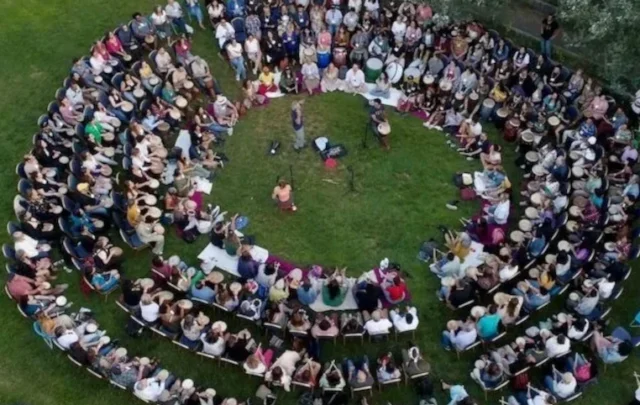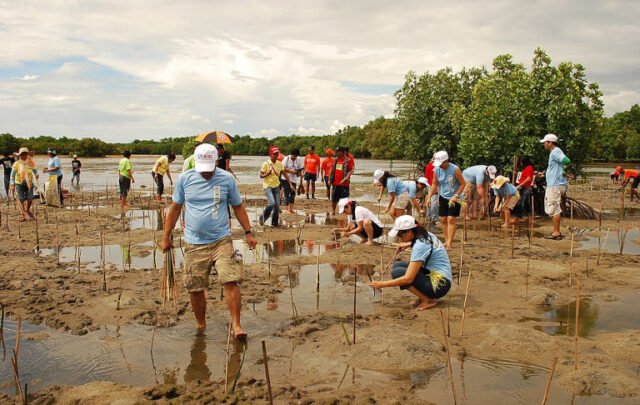 In 1856 – 163 years ago – Eunice Foote discovered that carbon dioxide is a greenhouse gas and was the first to link increased amounts of the gas to heating up our planet. Not only was she an accomplished scientist, but also an important player in the early women’s movement. Foote spent her formative years in upstate New York, then the last stop on the Underground Railroad taking runaway slaves to Canada and freedom. This was the epicenter for insurrectionists of all stripes: abolitionists, feminists, mystics, and teetotalers. It’s where “bloomers” were popularized as practical clothing for women in defiance of corsets and other fashion accessories designed to hobble and shackle their wearers. In 1848, Foote would sign the Magna Carta of the women’s movement, the Seneca Falls Declaration of Sentiments. She was chosen by those attending convention as one of just five signatories tasked to get the declaration published by famed abolitionist Frederick Douglass, who just happened to run a printing press down the road in Rochester.1 Among the other five was her next-door neighbor, the pioneering feminist Elizabeth Cady Stanton; it turned out Foote’s husband, Elisha Foote learned the law from Cady Stanton’s father. Foote’s son-in-law would later introduce the constitutional amendment banning slavery. It was that kind of progressive place.
In 1856 – 163 years ago – Eunice Foote discovered that carbon dioxide is a greenhouse gas and was the first to link increased amounts of the gas to heating up our planet. Not only was she an accomplished scientist, but also an important player in the early women’s movement. Foote spent her formative years in upstate New York, then the last stop on the Underground Railroad taking runaway slaves to Canada and freedom. This was the epicenter for insurrectionists of all stripes: abolitionists, feminists, mystics, and teetotalers. It’s where “bloomers” were popularized as practical clothing for women in defiance of corsets and other fashion accessories designed to hobble and shackle their wearers. In 1848, Foote would sign the Magna Carta of the women’s movement, the Seneca Falls Declaration of Sentiments. She was chosen by those attending convention as one of just five signatories tasked to get the declaration published by famed abolitionist Frederick Douglass, who just happened to run a printing press down the road in Rochester.1 Among the other five was her next-door neighbor, the pioneering feminist Elizabeth Cady Stanton; it turned out Foote’s husband, Elisha Foote learned the law from Cady Stanton’s father. Foote’s son-in-law would later introduce the constitutional amendment banning slavery. It was that kind of progressive place.
While in her teens, Foote attended Troy Female Seminary, whose students were invited to attend science lectures at a school that later became Rensselaer Technological University. An ex-con named Amos Eaton, who had been sentenced to life in prison for fraud but was released after four years so he could pursue his life calling as an evangelist of scientific education, had started the university.
Eaton believed that men and woman should have equal access to education in the sciences; definitely a wild idea back in the early nineteenth century. To fulfill his goal, he mentored a teacher at the Female Seminary, who established the first all- encompassing science curriculum for women, one that was equal to or better than any offered to men. Eaton also oversaw the construction of chemistry labs at both schools, the first in the world built solely for students. It was here where Eunice developed her experimental scientific skills.
She quickly learned at the Troy Female Seminary and from reading scientific journals that early nineteenth-century scientists were keenly interested in studying the role atmospheric conditions played in the temperature on earth. Foote was the first, however, to isolate the component gases that make up the atmosphere, thus discovering which gas became the hottest in sunlight. It was, she discovered, carbon dioxide. She then deduced that the more CO2 that’s pumped into the atmosphere, the hotter it gets. Then she brilliantly concluded from these two discoveries, “if … at one period of time of the [earth’s] history the air had mixed with a larger proportion than at present, an increased temperature from its own action … must have resulted.”2

Eunice Foote’s work was presented to a national gathering of American scientists in Albany in 1856. Unlike the male presenters, Eunice was not allowed to present her own paper because of her gender. A male surrogate, TBA Henry, the first Director of the Smithsonian Institution, had to read it in her place. Three weeks later, Scientific American enthusiastically published the significance of her work in answering several scientific issues that had baffled her male peers, as proof that women could do scientific work of the highest quality and significance. Her paper was also published in the pages of America’s top science journal, the American Journal of Science, and in journals across the Atlantic as well. Three years later, the renowned Irish scientist John Tyndall would publish an article of his own covering the same topic – atmospheric heating by carbon dioxide – declaring his work as utterly original and unprecedented.3 He failed to credit Foote’s work though Foote’s findings were published five years earlier, contradicting the veracity of his claim. Could this be another instance of a male scientist seeking notoriety thorough intellectual theft of a woman’s scientific work? He definitely could have gotten away with it as he ranked as a powerful male scientific professional while Eunice Foote was a mere woman and an amateur at that.
To this day the vast majority of the scientific community honors Tyndall for the discovery that adding carbon dioxide to the atmosphere is the primary cause of global warming – despite Foote’s undisputable priority. My forthcoming book, Science Knows No Gender hopes to change this travesty, giving Eunice Foote her deserving place among the pantheon of great scientists.
What relevance this has today, when climate change and women’s rights remain excruciatingly front and center, I’ll leave it to you, dear reader, to determine.
Certain echoes, however, are impossible to ignore. And isn’t this what makes Eunice Foote’s story so relevant to our times?4
What adds more spice to Eunice Foote’s story is that it may finally put to rest that wrong-headed idea which persists to this day – that men are more genetically predisposed to do great science than women. An example of such shared nonsense occurred as late as January 2005, when the Boston Globe reported that Larry Sommers, then president of Harvard University stated “that innate differences between men and women might be one reason fewer women succeed in science and math careers.”5 In the same vein, a Google engineer passed along a memo in 2017 advocating “that the distribution of preferences and abilities of men and women differ in part due to biological causes and that these differences may explain why we don’t see equal representation of women in tech and leadership.”6
Are these statements any different than back in Eunice Foote’s early days, when a person could write, “From the nature of chemical experiments, which in most cases either require firmness of nerve, unshrinking courage, or physical strength, and sometimes all of these qualities combined, woman may not aspire to add to the stock of chemical science, discoveries of her own.”7
 The experiments that led Eunice Foote to discover that adding carbon dioxide into the atmosphere is the principal cause of global warming and changes in the amount of carbon dioxide into the atmosphere at different periods of the earth’s history has had a major effect on the temperature of the surface of the earth prove how incorrect this misogynist sentiment was and remains to this day. The experiments she designed and conducted show all the attributes of a great scientist at work: choosing a major scientific issue that had yet to be dealt with – the individual components and states of the atmosphere and their relationship with the sun and earth; developing original experiments; devising appropriate and original apparatuses; and publishing and generalizing the consequences of her results to the past, present and future conditions of the world at large.8 Publishing her story will help to put an end that mean notion, as Scientific American wrote 162 years ago, that “some have not only entertained but expressed that women do not possess the strength of mind necessary for scientific investigations.”9
The experiments that led Eunice Foote to discover that adding carbon dioxide into the atmosphere is the principal cause of global warming and changes in the amount of carbon dioxide into the atmosphere at different periods of the earth’s history has had a major effect on the temperature of the surface of the earth prove how incorrect this misogynist sentiment was and remains to this day. The experiments she designed and conducted show all the attributes of a great scientist at work: choosing a major scientific issue that had yet to be dealt with – the individual components and states of the atmosphere and their relationship with the sun and earth; developing original experiments; devising appropriate and original apparatuses; and publishing and generalizing the consequences of her results to the past, present and future conditions of the world at large.8 Publishing her story will help to put an end that mean notion, as Scientific American wrote 162 years ago, that “some have not only entertained but expressed that women do not possess the strength of mind necessary for scientific investigations.”9
At the time of her experiments, the Industrial Revolution fueled by coal blasted away, returning carbon so intelligently buried by nature for hundreds of millions of years in the past as coal, back into the atmosphere and began turning up the global thermostat that now is inexorably transforming the only known living planet into a future dead Venusian Hell. While both the acolytes of Adam Smith and Karl Marx worshipped the fossil-fueled industrial revolution as the driver toward the paradise that the invisible hand of the market or the golden age of communism would create, Eunice Foote’s experiments reveal the fatal flaw on which these dreams were made and that would one day turn into the nightmare we are just beginning to wake.
Endnotes
1 Judith Wellman, The Road to Seneca Falls: Elizabeth Cady Stanton and the First Woman’s Rights Convention, 2004, 204.
2 Eunice Foote, 1856, 383.
3 John Tyndall, “The Bakerian Lecture: On the Absorption and Radiation of Heat by Gases and Vapours, and on the Physical Connexion of Radiation, Absorption, and Conductivity,” Philosophical Transactions of the Royal Society, Volume 151, Introduction, 1861.
4 Nick Welsh, “John Perlin Rediscovers Feminist Crusader Who Discovered Climate Change,” Santa Barbara Independent, May 10, 2018.
5 Marcella Bombardier, “Summers’ remarks on women, draw fire,” Boston Globe, January 17, 2005, http://archive.boston.com/news/education/higher/articles/2005/01/17/summers_remarks_on_women_draw_fire
6 James Damore, July 2017, “Google’s Ideological Echo Chamber: Howe Bias Clouds Our Thinking About Diversity and Inclusion, https://www.dhillonlaw.com/wp-content/uploads/2018/01/Damore-Google-Manifesto.pdf
7 Mrs. Almira Phelps, Lectures to Young Ladies…, 1833, 196.
8 Elizabeth Wagner Reed, American Women in Science before the Civil War, 1992, 68.
9 “Scientific Ladies: Experiments with Condensed Gases,” Scientific American, September 13, 1856, 5, https://babel.hathitrust.org/cgi/pt?id=coo.31924080787660;view=1up;seq=9
Teaser photo credit: Group portrait monument to the pioneers of the woman suffrage movement, sculpted by Adelaide Johnson (1859–1955) features Elizabeth Cady Stanton, Susan B. Anthony and Lucretia Mott. The portraits are copies of the individual busts Johnson carved for the Court of Honor of the Woman’s Building at the World’s Columbian Exhibitionin 1893





